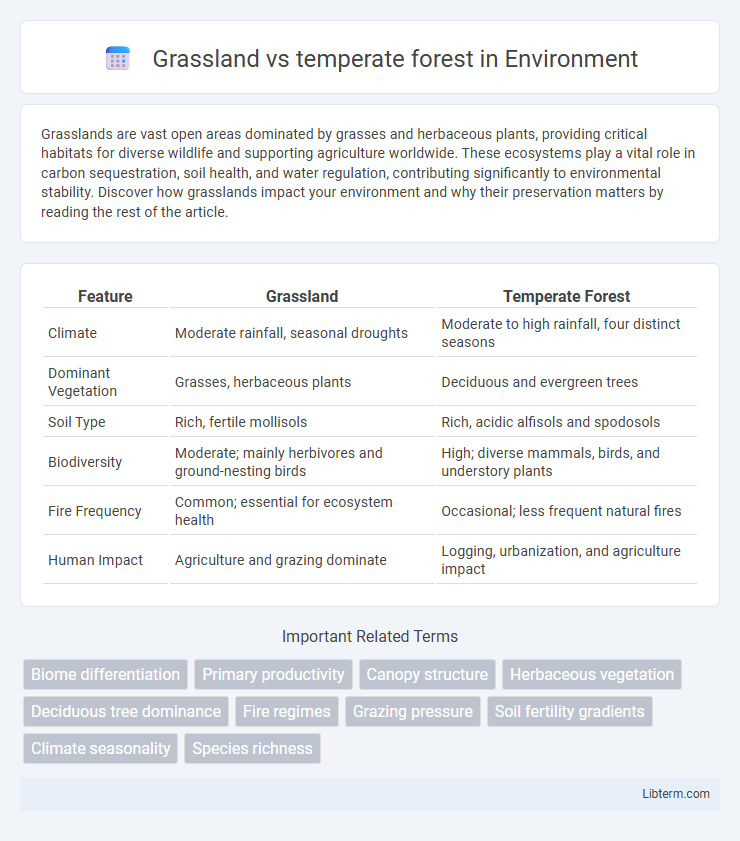Grasslands are vast open areas dominated by grasses and herbaceous plants, providing critical habitats for diverse wildlife and supporting agriculture worldwide. These ecosystems play a vital role in carbon sequestration, soil health, and water regulation, contributing significantly to environmental stability. Discover how grasslands impact your environment and why their preservation matters by reading the rest of the article.
Table of Comparison
| Feature | Grassland | Temperate Forest |
|---|---|---|
| Climate | Moderate rainfall, seasonal droughts | Moderate to high rainfall, four distinct seasons |
| Dominant Vegetation | Grasses, herbaceous plants | Deciduous and evergreen trees |
| Soil Type | Rich, fertile mollisols | Rich, acidic alfisols and spodosols |
| Biodiversity | Moderate; mainly herbivores and ground-nesting birds | High; diverse mammals, birds, and understory plants |
| Fire Frequency | Common; essential for ecosystem health | Occasional; less frequent natural fires |
| Human Impact | Agriculture and grazing dominate | Logging, urbanization, and agriculture impact |
Introduction to Grasslands and Temperate Forests
Grasslands cover approximately 20-40% of the Earth's land surface and are dominated by grasses, with few trees due to limited rainfall averaging between 250-750 mm annually. Temperate forests, found primarily in North America, Europe, and parts of Asia, receive between 700-1500 mm of precipitation and support diverse deciduous and coniferous tree species. The distinct climate patterns and soil types in these biomes influence their vegetation structure, biodiversity, and ecological functions.
Key Environmental Differences
Grasslands feature vast open spaces with dominant grasses and few trees, experiencing moderate rainfall typically between 250 to 750 mm annually, which supports drought-resistant plant species. Temperate forests receive higher annual precipitation ranging from 750 to 1500 mm and consist of diverse deciduous or evergreen tree species, creating dense canopy layers with rich understory vegetation. Soil in grasslands tends to be nutrient-rich and deep due to minimal tree root systems, while temperate forest soils are often acidic and enriched by decaying leaf litter, influencing distinct ecological processes in each biome.
Climate and Weather Patterns
Grasslands experience moderate rainfall ranging from 500 to 900 millimeters annually, with distinct wet and dry seasons and temperature fluctuations between hot summers and cold winters. Temperate forests receive higher precipitation, typically between 750 to 1,500 millimeters per year, distributed more evenly across seasons, supporting dense tree growth. Both biomes endure seasonal temperature variations, but temperate forests maintain more consistent moisture levels, influencing soil fertility and biodiversity.
Soil Composition and Fertility
Grasslands typically have deep, nutrient-rich topsoil composed of organic matter from decaying roots, supporting high fertility ideal for agriculture. Temperate forests feature a thicker layer of leaf litter and organic material on the surface, but their soil often has lower nutrient availability due to slower decomposition and leaching. The high humus content in grassland soils enhances moisture retention and nutrient cycling, making them more fertile compared to the often acidic and nutrient-poor soils of temperate forests.
Biodiversity and Ecosystem Dynamics
Grasslands exhibit high biodiversity of herbaceous plants and large grazing mammals, driving nutrient cycling through deep-rooted grasses that enhance soil health and carbon storage. Temperate forests contain diverse tree species, understory plants, and abundant fauna, with complex trophic interactions supporting multiple ecological niches and promoting robust ecosystem resilience. Both biomes play crucial roles in carbon sequestration but differ in structure and species composition, influencing ecosystem dynamics and habitat functions.
Plant Life: Grasses vs. Trees
Grasslands are dominated by a diverse array of grasses such as bluestem, buffalo grass, and ryegrass, which have deep root systems adapted to withstand drought and frequent fires. Temperate forests primarily consist of deciduous and coniferous trees like oak, maple, pine, and fir, which create a multilayered canopy providing habitats for diverse understory plants. The plant life in grasslands favors resilience and rapid regrowth, while temperate forests support a complex vertical structure with significant biodiversity in both trees and understory vegetation.
Animal Adaptations and Wildlife
Grasslands host large herbivores such as bison and zebras with adaptations for grazing and long-distance migration to access scattered water sources, while predators like lions exhibit stealth and speed to capture prey in open terrain. Temperate forests support diverse wildlife including deer and black bears with camouflage and climbing abilities suited for dense vegetation, alongside birds that exploit varied canopy layers for nesting and foraging. Animal adaptations in these biomes reflect evolutionary responses to distinct climates, vegetation structures, and seasonal resource availability.
Human Impact and Land Use
Grasslands experience significant transformation due to agriculture, livestock grazing, and urban development, leading to habitat fragmentation and soil degradation. Temperate forests face deforestation primarily from logging, land conversion for agriculture, and infrastructure expansion, which reduces biodiversity and alters carbon storage. Both ecosystems are increasingly impacted by human activities, necessitating sustainable land use practices to maintain ecological balance and support ecosystem services.
Conservation Challenges and Strategies
Grasslands face conservation challenges such as habitat loss due to agricultural expansion, invasive species, and altered fire regimes, requiring strategies like controlled burns, restoration of native plant species, and protection of remaining prairie ecosystems. Temperate forests struggle with deforestation, climate change impacts, and habitat fragmentation, necessitating sustainable logging practices, reforestation efforts, and establishment of wildlife corridors. Both biomes benefit from community engagement and policies promoting biodiversity to enhance ecosystem resilience and long-term conservation success.
Future Outlook for Grasslands and Temperate Forests
Grasslands are projected to face increased risks from land-use change and climate variability, with potential losses in biodiversity and ecosystem services such as carbon sequestration. Temperate forests are expected to experience shifts in species composition and increased vulnerability to pests, diseases, and wildfires due to rising temperatures and altered precipitation patterns. Conservation strategies and sustainable land management practices will be critical in mitigating these impacts and preserving the ecological functions of both biomes.
Grassland Infographic

 libterm.com
libterm.com